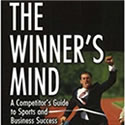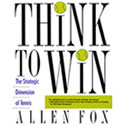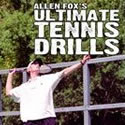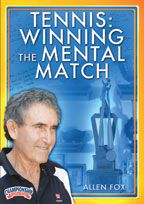Arthur Ashe Personified Talent and Class

Arthur Ashe was a fantastic physical talent. He also had the strength of character to overcome emotional difficulties with logic and willpower and make a champion of himself. In his early years Arthur had a tendency to become discouraged when he got behind, and this caused him to lose matches that he might have won. But he was unusual in overcoming this emotional difficulty with character and discipline, and so became a near-great player in spite of it. The lesson to be learned from Arthur is that people can change emotional habits, just like physical habits.
I first met Arthur Ashe at UCLA where I was a graduate student, and he was an in-coming freshman. He was a highly-ranked junior but not the best junior in the country, that honor falling to Charlie Pasarell, his freshman teammate. Arthur was friendly. Off the court he appeared relaxed, smiled and laughed a lot, amiable and chatty. But on the court he was cool, reserved, aloof, almost casual, and displayed a well-controlled temper. Unusual as it may be, I can not recall Arthur EVER getting angry on a tennis court, either in matches or in practice. I cannot make the same claim for myself, even though I was four years Arthur’s senior, or for Charlie Pasarell. (Charlie and I were yelling and cursing so much in our practice matches that our coach, JD Morgan, threatened to ban us from ever again practicing together on the UCLA courts.)
But Arthur’s tendency to become discouraged and quit when he got behind worked to my great benefit in his early years at UCLA. I played and beat him a half-dozen times during that span, mainly by hustling and forcing Art to bear down on each point so that he would mentally tire. I could not match his variety of shot and power, but I could hang with Arthur until he emotionally weakened. I learned that if I fought hard enough and long enough he would eventually become disheartened, make mistakes, and hand me the match. It was really the only way I could beat him, and it worked quite well when he was young and inexperienced. Unfortunately for me he did not stay young and inexperienced long enough. And when he matured he gave me a couple of the worst beatings I had ever experienced.
He had simply figured out that getting discouraged was not a good idea and stopped doing it. By his early twenties Arthur had toughened up considerably, and by the end of his career he could hang in matches quite well. He generally did not hang as tough as the truly great players of the day, like Laver, Newcombe, Gonzales, Santana, Emerson, etc., but he was an excellent big match player and tough enough to win a couple of Slam events, So he certainly became pretty tough.
Arthur was very hard to play against. In fact he was downright unpleasant. His most fearsome weapon was his first serve. It was a very relaxed, effortless delivery, not terribly powerful, but hit flat and with incredible deception. I used to just stand there watching it go by again and again. He liked hitting it to the forehand side, wide in the deuce court and down the middle in the ad court. I knew this, but for the life of me I could never see it coming. Worse yet, he was exceptionally good at acing you on the big points; in particular if you held 30 – 40 on his serve. In those days there were a number of big servers that could make your life miserable, especially on the grass surface where most big matches were held, but not one of them could ace you as easily and often as Arthur.
On the other hand, his second serve was relatively weak. He hit it with more slice than topspin and it was light and easy to return. Arthur followed both of his serves to the net, but since he was neither a great volleyer nor exceptionally fast on his feet, he was quite vulnerable on his second serve. If you were able to hit a solid, low return you had a good chance to pass Arthur on the next shot. Unfortunately for his opponents this weakness was usually not enough to offset the incredible strength of his first serve so, on balance, it was very difficult to break Arthur’s serve.
Arthur could hit topspin with both his forehand and backhand, following a new trend in the game set by Rod Laver. Like Laver, Arthur was wonderfully gifted with his hands and could do virtually anything with the ball. He could hit any ball into any place in the court without indication, particularly with his backhand, which was his better side. He varied his shots continually, rarely hitting two of the same shots in a row. He would mix in slices, topspins, drop shots, flat balls, and topspin lobs randomly and effortlessly. When you played him you never knew what was coming next and were perpetually off balance. It was very difficult to play well against him, and you often missed shots you normally made because you were so off balance and confused by his choice of shot and placement. On the other hand Arthur also made a lot of mistakes, and against the great players of his day, this was his too often his undoing.
In assessing Arthur’s stature as a player we must first take note of the fact that he won the US Open once, the Australian once, and Wimbledon once (defeating Jimmy Connors at his peak in 1975). These wins make it obvious that he was an excellent big match player. But he was not a dominating player, and was never the best player in the world. On a head to head basis he was not nearly as good as the truly great players of his time like Ken Rosewall, Pancho Gonzales, Roy Emerson, Manuel Santana, or Rod Laver. These players could and did beat him regularly. He was not quite as good as John Newcombe or Stan Smith either, although he was certainly able to beat them from time to time. But he was a better player than Fred Stolle who also won the US Championship during this time period. Arthur just had too many weaknesses in his game to overcome the very best players day in and day out. But his greatness lay in his ability to take advantage of opportunities and win three of the four most important tournaments in the world.
Although he didn’t show it, Arthur used to get very nervous, and before important matches his stomach was in knots. We played doubles together at Wimbledon in 1963, the first time either of us had played in Europe (I’m including the U.K. as part of Europe), and we both choked like dogs against the top Russian doubles team on the center court. The Russians were as nervous as we were, and the tennis was so bad that spectators were fighting to get out. I was even hoping the Russians would hit some good shots so the people would stick around. Arthur served for the first set. On the first point the Russians floated back a high, soft return, and I waited for Arthur to charge in on top of the net and knock it off. But he never showed up. He was so nervous that he only managed to take two steps inside the baseline and hit a swing volley that went into the back fence. (Of course I should have poached but I was also paralyzed.) We went on to drop that game as well as the match. Arthur later learned to control his nerves but the inner man was certainly not the cool, emotionless person that the spectators saw. It took tremendous effort and discipline for Arthur to appear so casual and relaxed.
A great deal has been said about Arthur’s generous nature and his devotion to his community and principles. I almost feel silly adding to his legend because after a person dies there is often a tendency to endow him with false and unrealistic virtues. Arthur has, in fact, been virtually deified. On the other hand I knew him as person and a friend, and it is hard for me to think of him as a Saint even though he was a lot closer to being one than anyone else I know (other than, of course, of my wife, Nancy).
I personally witnessed many of his selfless acts, but one that stands out in my mind occurred in 1969, the year that tennis went from an amateur to a professional (Open) game. Previously, we had all played as amateurs, and nobody made substantial money. We were paid a few hundred dollars here and there and were put up in the finest hotels, so I’m not complaining, but we played mainly for the love of competition, the travel, the camaraderie, and fun of the tour.
But when the game went open in 1969 the financial aspects changed. Now all the major tournaments were professional and played for significant prize money, players could get paid handsomely (we thought) for exhibitions, and equipment companies could advertize players and legitimately pay for product endorsements. And Arthur happened to win the US Open that year and become the hottest player in the game.
Lamar Hunt, an extremely wealthy Texas tennis enthusiast, began guaranteeing the top players large sums of money to sign contracts with him and obligate themselves to play events that he controlled and promoted. (His tennis entity was called World Championship Tennis, WCT.) He put together a group, called “the handsome eight”, which included players like Roy Emerson, Tony Roche, Dennis Ralston, Cliff Drysdale, and others, and he very much wanted Arthur to join. (Some of these guys were not all that handsome, but it was a catchy moniker, and maybe the women liked to see the guys running around in the skimpy shorts of the day.) With his almost unlimited capital, Lamar had decided to take over, build, and run the fledgling game of open, professional tennis. And since he had bought up almost all the big names, he was in an excellent position to do so. Arthur would have been the final jewel in his crown. So he offered Arthur an enormous sum of money to join, an amount so large that Arthur would have been financially independent thereafter. Since Arthur had no money at all this was very tempting.
But at the same time Arthur’s close friends, Donald Dell and Charlie Pasarell, wanted to start a company that they hoped would become an alternative force in the development of the new open game. And they needed Arthur to give the company power. They could not offer him money or any guarantees for the future. Here he faced significant risks. If Arthur had become injured and unable to play he would have been out of luck. If the new open game did not develop and prize money and endorsement money did not grow Arthur would have remained impoverished. All Donald and Charlie offered him was friendship and a chance to be what his friends termed, “a force for good in the developing game.” Lamar Hunt, on the other hand, was offering guaranteed financial security for life. I love my friends and feel I have high principles, but FINANCIAL SECURITY FOR LIFE? That’s unfairly tempting.
I happened to be present at some of the meetings where these positions were presented, and I watched Arthur choose friendship and principle over money. He didn’t hesitate. And his little group went on to lay the groundwork for today’s ATP and the wonderful tour that the players now enjoy.
Notice: link_pages is deprecated since version 2.1.0! Use wp_link_pages() instead. in /home3/allenfox/public_html/allenfoxtennis/wp-includes/functions.php on line 3896
If you enjoyed this post, please consider to leave a comment or subscribe to the feed and get future articles delivered to your feed reader.
Warning: compact(): Undefined variable $limits in /home3/allenfox/public_html/allenfoxtennis/wp-includes/class-wp-comment-query.php on line 853
Warning: compact(): Undefined variable $groupby in /home3/allenfox/public_html/allenfoxtennis/wp-includes/class-wp-comment-query.php on line 853
Deprecated: ltrim(): Passing null to parameter #1 ($string) of type string is deprecated in /home3/allenfox/public_html/allenfoxtennis/wp-includes/wp-db.php on line 2818
Warning: get_comment(): Argument #1 ($comment) must be passed by reference, value given in /home3/allenfox/public_html/allenfoxtennis/wp-includes/class-wp-comment-query.php on line 458
Warning: get_comment(): Argument #1 ($comment) must be passed by reference, value given in /home3/allenfox/public_html/allenfoxtennis/wp-includes/class-wp-comment-query.php on line 458
Warning: get_comment(): Argument #1 ($comment) must be passed by reference, value given in /home3/allenfox/public_html/allenfoxtennis/wp-includes/class-wp-comment-query.php on line 458
Warning: compact(): Undefined variable $limits in /home3/allenfox/public_html/allenfoxtennis/wp-includes/class-wp-comment-query.php on line 853
Warning: compact(): Undefined variable $groupby in /home3/allenfox/public_html/allenfoxtennis/wp-includes/class-wp-comment-query.php on line 853






Great article Allen. I really admired Arthur a lot. Tim
Very informative piece. I remember that you once described Arthur as a “magician” on the court. I now have a much better idea of what you meant.
Really good article about a really good player. Ashe was hard to figure as a player, he was not really fast or strong, didn’t seem all that athletic, and he did not seem super-fit. He was not one of those athletes who probably could have been great at any sport. But he was very skilled and I think Dr. Fox is right that he had great hands, maybe the best, and this can’t be taught, it is God-given. He hit the ball pretty flat, kind of slapped at it, even on the volley, but it worked, especially on the fast courts of that era, his shots really seemed to skid and stay low, making it tough to pass him at net. His movement was very good side-to-side and he had a great overhead, which was good because he was at the net a lot. Different era, when it was all about fast courts, holding serve, and breaking serve enough to win the match.